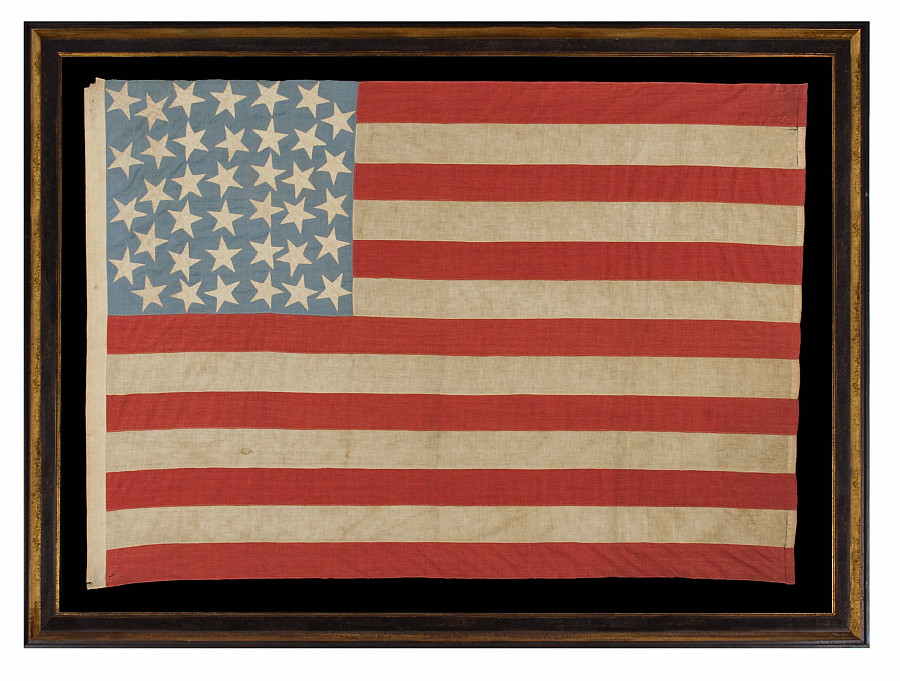
| |
38 STARS IN AN INTERTWINED "DOUBLE-S" CONFIGURATION, ON A CORNFLOWER BLUE CANTON THAT RESTS UPON THE WAR STRIPE, 1876-1889, COLORADO STATEHOOD |
|
| Available: |
Sold |
| Frame Size (H x L): |
Approx. 59" x 72" |
| Flag Size (H x L): |
48" x 71" |
|
| Description....: |
|
38 STARS IN AN INTERTWINED "DOUBLE-S" CONFIGURATION, ON A CORNFLOWER BLUE CANTON THAT RESTS UPON THE WAR STRIPE, 1876-1889, COLORADO STATEHOOD:
38 star American national flag with an extraordinary combination of features. The most obvious of these include two intertwined, serpentine formations of stars and the light, cornflower blue canton on which they are sewn. Because there was no official star pattern for the American flag until 1912, and no specified shades of blue or red, the star configuration and colors were left to the discretion of the flag-maker. In fact, all manner of liberty were taken with flag design. The result was many times terrific, as it is in the case of this late-19th-century example.
The two overlapping, reverse "S" formations seen here might be purposeful or purely accidental. Perhaps the maker was simply trying to place the stars in columns and didn't plan them well. But whatever the case may be, the result is both interesting and quite striking. It's difficult for one's eye to rest because of the unusual amount of movement in the steady flow of the pattern. The stars are also quite large with respect to the available space; so-much-so that they overlap one-another, which adds further visual appeal.
Because there was no particular orientation for a flag until around 1890, when ethics began to emerge relevant to its care and use, either side could be viewed as the front. Text was sometimes painted or printed on the stripes for the purposes of advertising and, when this was the case, it might only occur on one side. It might fall on what we now might call the front or the "obverse", but could just as easily be placed on what we now call the reverse side of the flag. Stars were generally placed back-to-back on either side of the canton, so that their stitching wouldn't show on the opposing sides. With these two facts in mind, it's easy to understand why someone might desire to configure the stars purposely into the shape of two "S's", but that their orientation would by necessity be backwards on one side of the flag or the other.
A feature even more peculiar is the fact that the canton rests on a red stripe. This is a very rare trait. Some flag historians refer to this as the "blood stripe" or the "war stripe", suggesting the flag was sometimes constructed in this manner when the nation was at war. There is also evidence, however, that the U.S. Navy used this design feature on at least some of its flags made during the mid-19th century, but sometimes the feature was certainly accidental. Due to the many Civil War veterans were now involved in the Indian wars that raged throughout the Western States, the placement may very well have been purposeful. In any event, it is a rare and desirable feature.
The 38th state, Colorado, received its statehood on August 1st, 1876. This was the year of our nation's centennial of independence from Great Britain. Although 37 was the official star count for the American flag in 1876, flag-making was a competitive venture, and no one wanted to be making 37 star flags when others were making 38's. It is for this reason that 38 and 13 stars (to represent the original 13 colonies) are the two star counts most often seen at the Centennial International Exposition, the six-month long, World's Fair event, held in Philadelphia in honor of the anniversary. The 38 star flag became official in 1877 and was generally used until the addition of the Dakotas in 1889.
All-in-all this is a dynamic and colorful, centennial era flag and a great example of the war stripe phenomenon in 19th century flag-making.
Construction: The stars of the flag are hand-sewn, made of cotton, and double-appliqued. This means that they were applied to both sides of the canton. The canton and stripes are made of cotton, pieced with treadle stitching, and there is a cotton sleeve along the hoist.
Mounting: The flag was hand-stitched to 100% silk organza on every seam for support, then hand-stitched to a background of 100% cotton twill, black in color, which has been washed to remove excess dye. An acid-free agent was added to the wash to further set the dye and the fabric was heat-treated for the same purpose. The mount was then placed in a black-painted, hand-gilded and distressed Italian molding. The front is U.V. Protective acrylic.
Condition: There is minor fabric loss at the top and bottom of the hoist where the flag was likely tacked to a wooden staff. There is a tiny hole in the last red stripe, very near the hoist. There is minor foxing and staining throughout. Many of my clients prefer early flags to show their age and history of use. |
|
|
|
| Collector Level: |
Advanced Collectors and the Person with Everything |
|
| Flag Type: |
Sewn flag |
|
| Star Count: |
38 |
|
| Earliest Date of Origin: |
1876 |
|
| Latest Date of Origin: |
1889 |
|
| State/Affiliation: |
Colorado |
|
| War Association: |
1866-1890 Indian Wars |
|
| Price: |
SOLD |
|
| |
Views: 3398 |
|
|
|

